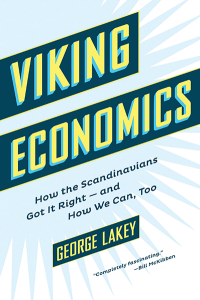Viking Economics: How the Scandinavians Got It Right—and How We Can, Too

BOOK BY GEORGE LAKEY
MELVILLE HOUSE, 2016
304 PP.; $26.99
Today, a birth lottery winner (or a chooser behind a Rawlsian veil of ignorance) would likely end up not as a US billionaire’s child (much less a random US child), but as a child in Scandinavia. That is, whether you’re looking for higher happiness, longer life expectancy, and better health, education, safety, and quality of life, or you’re looking for environmental sustainability, social justice, and relations of peace and generosity with the rest of the world, the model today is the land of the Vikings’ descendants.
Traditionally it hasn’t been popular in the United States to emulate others. For example, Michael Moore’s latest movie, Where to Invade Next, isn’t his highest grossing. Likewise, books on how Europe is better than here don’t usually fly off US shelves. On the other hand, Senator Bernie Sanders (D-VT) made the Scandinavian model the core of his surprisingly successful presidential campaign. Many voices were quick to tell him that his socialism doesn’t work in theory. He was quick to reply that it has nonetheless been proven to work in practice.
The United States was once thought of as a laboratory of experimentation. When one state arrived at a more successful public policy, the other forty-nine could benefit and follow suit. Scandinavia has worked that way over the past several decades; when Norway, Sweden, Denmark, or Iceland has found something that works or fails, the other nations have benefitted from the knowledge. So when the Swedish government experiments with shorter working hours to determine whether they increase or decrease productivity, there is a widespread expectation that future policy will follow whatever the results show.
In the United States, however, there’s a general expectation that public policy will follow financial corruption. Whether a war on terrorism increases or decreases terrorism is not a question that’s studied with any anticipation of policy change following what’s learned. Does mass incarceration increase or decrease crime? That’s not a field of study lent the urgency it would get if anybody believed our government would act on the findings. Has restricting guns in Australia, or responding to a mass shooting with a measure of sanity in Norway worked well? The US expectation remains that Congress will do what the funders of election campaigns prefer.
And so, there are two senses in which I believe we need to become more Viking. One is by pursuing what works economically. The other is by educating and organizing to bring about and sustain change. For both reasons I hope that George Lakey’s new book, Viking Economics: How the Scandinavians Got it Right—and How We Can, Too, becomes a bestseller.
Just imagine a United States in which, in return for your taxes, you received top quality education from preschool through college or trade school, top-quality healthcare, low working hours, long vacations, family and parental leave, retirement, public transportation, childcare, adult education, environmental sustainability, and, in fact, all the advantages that the United States supposedly now holds: a wider range of opportunity, greater class mobility, more entrepreneurs per capita, more patents, more creativity.
As Lakey documents extensively, this didn’t happen in Scandinavia by chance, or because its nations are small, or because they’re homogenous, or because Norway has oil. These nations developed Viking economics through extensive, relentless, and nonviolent organizing and protest, including resistance to the US/UK push toward the right that began in the 1980s. From the early twentieth century on, organizers took a universal approach, including the unemployed in labor unions, pressing for policies that benefit all rather than a select population. (Imagine the Wobblies having set the agenda rather than the American Federation of Labor.)
Norway ranks number one among the twenty-seven richest nations in how it welcomes and integrates asylum seekers and refugees. It does so in a manner that draws on how Viking economics welcomes anyone who has become unemployed. Rather than creating programs of charity for the poor, which the poor never manage to find the political clout to maintain, Scandinavian countries have created programs for training, counseling, and job placement for anyone and everyone who hasn’t found satisfying employment. There’s no stigma attached to government programs, and there’s widespread consensus on upholding or expanding them.
Rather than bailing out bankers who damage economies, or bowing to the European Union or International Monetary Fund (IMF) demands for austerity, Scandinavian governments have upheld the rule of law, expanded social programs, and—in the case of Norway—temporarily nationalized banks to bring them under control. These actions, in each country, have followed massive public mobilization.
When Denmark’s government sought to impose Thatcherite austerity in 1984, workers didn’t just resist, didn’t just lobby, and didn’t just vote. They went on the offensive, demanding higher pay, shorter hours, and greater taxes on corporations. Then they surrounded and shut down the legislature until a compromise was reached.
When Iceland took the opposite course of the United States on banker shenanigans following the 2008 crash, it did so after people surrounded the parliament banging pots and pans so loudly that no work could be done. It also hired an economist named David Stuckler who discovered that in trying to impose austerity on Iceland the IMF had avoided actual numbers in order to use theoretical modeling to reach its trickle-down conclusions.
It’s time we faced the reality that government investment in something other than war or tax breaks for billionaires actually works, and that nobody is going to hand it to us or place it on a ballot.
